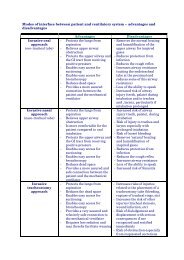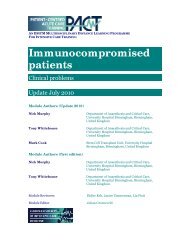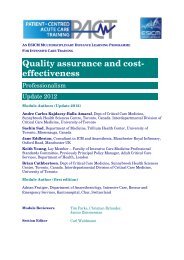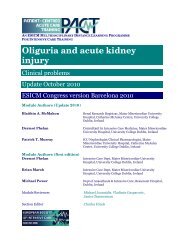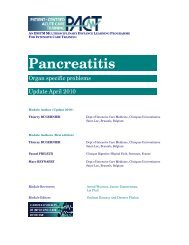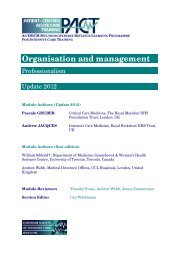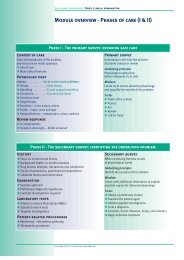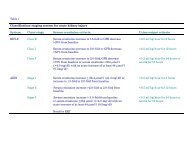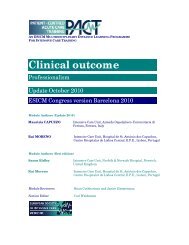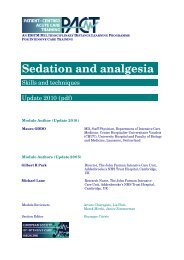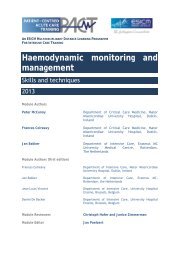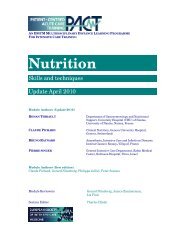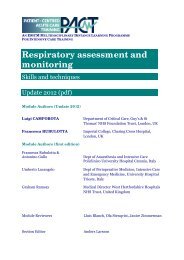Burns injury - PACT - ESICM
Burns injury - PACT - ESICM
Burns injury - PACT - ESICM
You also want an ePaper? Increase the reach of your titles
YUMPU automatically turns print PDFs into web optimized ePapers that Google loves.
See the <strong>PACT</strong> module on Airway management<br />
When inhalation <strong>injury</strong> is suspected, the indication to intubate should be<br />
broad and intubation carried out promptly. Late intubation is sometimes impossible<br />
leading to death by asphyxia, while extubating a patient without <strong>injury</strong> is simple and<br />
can be done rapidly after confirmation of absence of inhalation <strong>injury</strong>.<br />
Specific measures after inhalation <strong>injury</strong><br />
Lack of diagnostic criteria and large randomised trials make specific therapeutic<br />
recommendations in patients with inhalation <strong>injury</strong> difficult. Since 100% oxygen<br />
reduces the half-life of carbon monoxide (CO) it should be initiated as soon as<br />
possible (see CO intoxication). Once carboxyhaemoglobin levels have normalised,<br />
FiO 2 should be reduced. In a review article from 2011 on modern burn treatment,<br />
Kasten suggests that aggressive pulmonary toilet, nitric oxide, nebulised heparin, N-<br />
acetylcysteine, and/or bronchodilators may be considered in patients with inhalation<br />
<strong>injury</strong>. However with the exception of for aggressive broncho-pulmonary toilet, these<br />
measures are not standard care.<br />
Colohan SM. Predicting prognosis in thermal burns with associated inhalational<br />
<strong>injury</strong>: a systematic review of prognostic factors in adult burn victims. J<br />
Burn Care Res 2010; 31(4): 529–539. PMID 20523229<br />
Ikonomidis C, Lang F, Radu A, Berger MM. (2012) Standardizing the diagnosis of<br />
inhalation <strong>injury</strong> using a descriptive score based on mucosal <strong>injury</strong><br />
criteria. <strong>Burns</strong> 2012; 38(4): 513–519. PMID 22348802<br />
Palmieri TL. Inhalation <strong>injury</strong> consensus conference: conclusions. J Burn Care<br />
Res 2009; 30(1): 209–210. PMID 19060761<br />
Kasten KR, Makley AT, Kagan RJ. Update on the critical care management of<br />
severe burns. J Intensive Care Med 2011; 26(4): 223–236. PMID 21764766<br />
Carbon monoxide poisoning<br />
A high index of suspicion should always be maintained for carbon monoxide (CO)<br />
poisoning, particularly in high-risk injuries such as burns suffered in enclosed spaces<br />
and in patients with associated injuries which may have altered the level of<br />
consciousness. CO poisoning is responsible for many early deaths in burn victims due<br />
to anoxic encephalopathy.<br />
Diagnosis<br />
Carbon monoxide poisoning requires blood gas analysis by CO-oximeter, which will<br />
give accurate measurements of oxyhaemoglobin, carboxyhaemoglobin (COHb) and<br />
methaemoglobin. Arterial or venous blood can be used. Arterial blood gas analysis<br />
using the conventional blood gas machines may only demonstrate a metabolic<br />
acidosis.<br />
20



